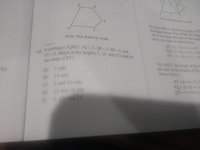This is GMAT question is from GMAT Official Guide 2019 Quantitative Review and the figure and word problem is in the image--- if you can't see it, then can someone make the picture look nice( I know someone on this forum knows how to do that somehow??). The answer is C
I used A squared + B squared = C squared
I did RS squared + ST squared = RT squared. That means 4 squared + 5 squared = 41. That means RT equals Square root of 41. Then you do RT squared plus QR squared = QT squared. 41 + 4 = 45 squared. QT = square root 45. Then you use PQ now and with QT you can find PT.
3 squared = 9. 9 plus PT squared = QT squared. Pt squared equals 36 and PT equals 6. PT equals 6, so how can I answer this question??
I used A squared + B squared = C squared
I did RS squared + ST squared = RT squared. That means 4 squared + 5 squared = 41. That means RT equals Square root of 41. Then you do RT squared plus QR squared = QT squared. 41 + 4 = 45 squared. QT = square root 45. Then you use PQ now and with QT you can find PT.
3 squared = 9. 9 plus PT squared = QT squared. Pt squared equals 36 and PT equals 6. PT equals 6, so how can I answer this question??

